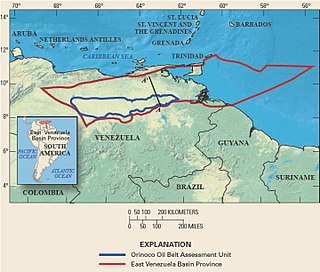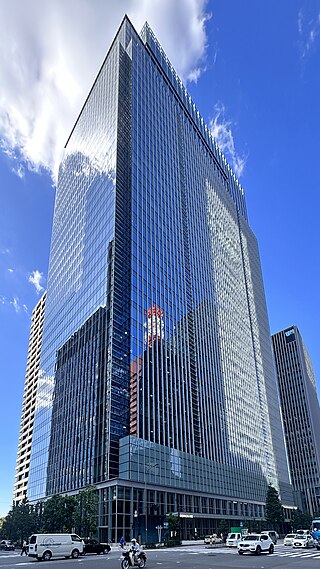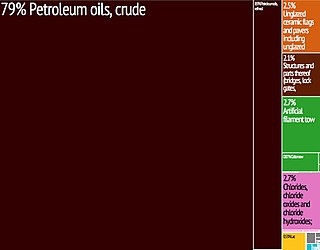Related Research Articles

Natron is a naturally occurring mixture of sodium carbonate decahydrate (Na2CO3·10H2O, a kind of soda ash) and around 17% sodium bicarbonate (also called baking soda, NaHCO3) along with small quantities of sodium chloride and sodium sulfate. Natron is white to colourless when pure, varying to gray or yellow with impurities. Natron deposits are sometimes found in saline lake beds which arose in arid environments. Throughout history natron has had many practical applications that continue today in the wide range of modern uses of its constituent mineral components.

The China National Petroleum Corporation (CNPC) is a major national oil and gas corporation of China and one of the largest integrated energy groups in the world. Its headquarters are in Dongcheng District, Beijing. CNPC was ranked fourth in 2022 Fortune Global 500, a global ranking of the largest corporations by revenue.

The Orinoco Belt is a territory in the southern strip of the eastern Orinoco River Basin in Venezuela which overlies the world's largest deposits of petroleum. Its local Spanish name is Faja Petrolífera del Orinoco.

Fluid catalytic cracking (FCC) is the conversion process used in petroleum refineries to convert the high-boiling point, high-molecular weight hydrocarbon fractions of petroleum into gasoline, alkene gases, and other petroleum products. The cracking of petroleum hydrocarbons was originally done by thermal cracking, now virtually replaced by catalytic cracking, which yields greater volumes of high octane rating gasoline; and produces by-product gases, with more carbon-carbon double bonds, that are of greater economic value than the gases produced by thermal cracking.
Petroleum production in Canada is a major industry which is important to the overall economy of North America. Canada has the third largest oil reserves in the world and is the world's fourth largest oil producer and fourth largest oil exporter. In 2019 it produced an average of 750,000 cubic metres per day (4.7 Mbbl/d) of crude oil and equivalent. Of that amount, 64% was upgraded from unconventional oil sands, and the remainder light crude oil, heavy crude oil and natural-gas condensate. Most of the Canadian petroleum production is exported, approximately 600,000 cubic metres per day (3.8 Mbbl/d) in 2019, with 98% of the exports going to the United States. Canada is by far the largest single source of oil imports to the United States, providing 43% of US crude oil imports in 2015.

QatarEnergy, formerly Qatar Petroleum (QP), is a state owned petroleum company of Qatar. The company operates all oil and gas activities in Qatar, including exploration, production, refining, transport, and storage. The President & CEO is Saad Sherida al-Kaabi, Minister of State for Energy Affairs. The company's operations are directly linked with state planning agencies, regulatory authorities, and policy making bodies. Together, revenues from oil and natural gas amount to 60% of the country's GDP. As of 2018 it was the third largest oil company in the world by oil and gas reserves. In 2022, the company had total revenues of US$52bn, a net income of US42.4bn, and total assets of US$162bn. In 2021, QatarEnergy was the fifth largest gas company in the world.
The National Oil Corporation is the national oil company of Libya. It dominates Libya's oil industry, along with a number of smaller subsidiaries, which combined account for around 70% the country's oil output. Of NOC's subsidiaries, the largest oil producer is the Waha Oil Company (WOC), followed by the Arabian Gulf Oil Company (Agoco), Zueitina Oil Company (ZOC), and Sirte Oil Company (SOC).

Burning of renewable resources provides approximately 90 percent of the energy in Uganda, though the government is attempting to become energy self-sufficient. While much of the hydroelectric potential of the country is untapped, the government decision to expedite the creation of domestic petroleum capacity coupled with the discovery of large petroleum reserves holds the promise of a significant change in Uganda's status as an energy-importing country.
Chad achieved independence in 1960. At the time, it had no armed forces under its own flag. Since World War I, however, southern Chad, particularly the Sara ethnic group, had provided a large share of the Africans in the French army. Chadian troops also had contributed significantly to the success of the Free French Forces in World War II. In December 1940, two African battalions began the Free French military campaign against Italian forces in Libya from a base in Chad, and at the end of 1941, a force under Colonel Jacques Leclerc participated in a spectacular campaign that seized the entire Fezzan region of southern Libya. Colonel Leclerc's 3,200-man force included 2,700 Africans, the great majority of them southerners from Chad. These troops went on to contribute to the Allied victory in Tunisia. Chadians, in general, were proud of their soldiers' role in the efforts to liberate France and in the international conflict.
Petroleum industry in Guyana is rapidly evolving. Guyana has emerged as one of the newest petroleum producing regions in the world, achieving its first commercial grade crude oil draw in December 2019. Crude oil is sent abroad for refining.
As of 2017, Azerbaijan produced a range of metals and industrial minerals, including aluminum, bentonite, copper, gold, iodine, limestone, silver and steel.

Petroleum has been a major industry in the United States since the 1859 Pennsylvania oil rush around Titusville, Pennsylvania. Commonly characterized as "Big Oil", the industry includes exploration, production, refining, transportation, and marketing of oil and natural gas products. The leading crude oil-producing areas in the United States in 2023 were Texas, followed by the offshore federal zone of the Gulf of Mexico, North Dakota and New Mexico.

Idemitsu Kosan Co., Ltd. is a Japanese petroleum company. It owns and operates oil platforms, refineries, produces and sells petroleum, oils and petrochemical products, and also operates gas stations under the apollostation brand and until 2023, in its own Idemitsu and Shell brands; the Shell brand being used under the license of Royal Dutch Shell.
The mineral industry of Paraguay includes the production of cement, iron and steel, and petroleum derivatives. Paraguay has no known natural gas or oil reserves. To meet its crude oil and petroleum products demand, Paraguay relies completely on results of approximately 25,400 barrels per day (4,040 m3/d) (bbl/d). The mining sector contributes little to the country's economy, accounting for only 0.1% of its gross domestic production (GDP).

Offshore oil and gas in the Gulf of Mexico is a major source of oil and natural gas in the United States. The western and central Gulf of Mexico, which includes offshore Texas, Louisiana, Mississippi, and Alabama, is one of the major petroleum-producing areas of the United States. Oil production from US federal waters in the Gulf of Mexico reached an all-time annual high of 1.65 million barrels per day in 2017. Oil production is expected to continue the upward trend in 2018 and 2019, based on ten new oil fields which are planned to start production in those years. According to the Energy Information Administration, "Gulf of Mexico federal offshore oil production accounts for 15% of total U.S. crude oil production and federal offshore natural gas production in the Gulf accounts for 5% of total U.S. dry production."
The oil industry in Poland began at Bóbrka Field in 1853, followed by the first refinery in 1854. Poland was the third most productive region in the world in 1900. It now has only a small, mostly state-owned component, with production from its Permian Basin in the west, small and very old fields in the Carpathians in the south, and offshore in the Baltic Sea. For natural gas the country is almost completely dependent on legacy pipelines from the former Soviet Union.
The history of the oil shale industry in the United States goes back to the 1850s; it dates back farther as a major enterprise than the petroleum industry. But although the United States contains the world's largest known resource of oil shale, the US has not been a significant producer of shale oil since 1861. There were three major past attempts to establish an American oil shale industry: the 1850s; in the years during and after World War I; and in the 1970s and early 1980s. Each time, the oil shale industry failed because of competition from cheaper petroleum.
The petroleum industry in Syria forms a major part of the economy of Syria. According to the International Monetary Fund, before the Syrian Civil War, oil sales for 2010 were projected to generate $3.2 billion for the Syrian government and accounted for 25.1% of the state's revenue.

Chad maintains sizable reserves of crude oil which, alongside agriculture, makes up the largest share of the landlocked former French colony's export revenue. Producing around 100,000 barrels of oil a day, most of Chad's crude comes from its reserves in the Doba Basin in southern Chad where oil was discovered in the early 1970s by foreign drillers. There is an estimated one billion barrels of oil in Chad, most of it being exploited by hundreds of rigs operated by Western companies such as Exxon-Mobil and Royal Dutch Shell. However, many challenges exist to Chad's petroleum industry including but not limited to corruption, internal conflict, and geography. Since Chad is landlocked, most of Chad's oil exports are transported out of the country by a pipeline that leads to the Cameroonian port city of Kribi. This pipeline, owned by a consortium, has come under fire due to allegations of exploitation by international corruption watchdogs, and Chadian politicians. In addition, environmentalists have voiced their concerns over the pipeline's impact on the natural environment, citing several spills.
Australia is a major petroleum producer and importer, with a number of petroleum companies involved in upstream and downstream operations. Western Australia is the largest contributor to Australia's production of most petroleum products.
References
- 1 2 3 4 5 6 7 8 9 10 11 12 13 14 15 16 17 18 19 20 21 22 Collelo, Thomas, ed. (1990). Chad: A Country Study (2nd ed.). Washington, D.C.: Federal Research Division, Library of Congress. pp. 111–112. ISBN 0-16-024770-5.
 This article incorporates text from this source, which is in the public domain.
This article incorporates text from this source, which is in the public domain.{{cite encyclopedia}}: CS1 maint: postscript (link) - ↑ Brachet & Scheele 2019, pp. 191–196.
- Brachet, Julien; Scheele, Judith (2019). The Value of Disorder : Autonomy, Prosperity, and Plunder in the Chadian Sahara. Cambridge: Cambridge University Press. ISBN 9781108566315.
